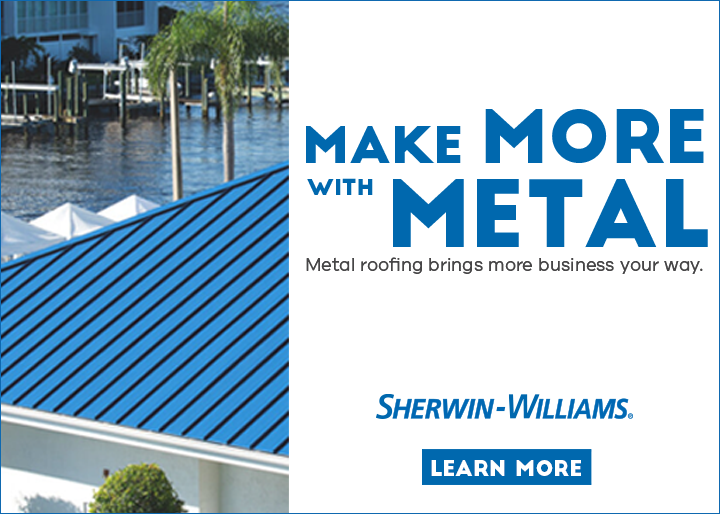UP TO THE MINUTE
Rodger Russ - Unlocking Retrofit Potential for Metal Roofs - PODCAST TRANSCRIPT
April 3, 2025 at 12:00 p.m.Editor's note: The following is the transcript of a live interview with Rodger Russ of Tremco. You can read the interview below or listen to the podcast.
Intro: Welcome to Metal Cast, the podcast where we're turning up the heat on all things metal roofing. On this show, we'll explore the world of metal roofing from its durability to design, expert insights and more. Join us as we bang out the details on the toughest roofs in the game. Get ready to unleash the power of metal roofing.
Heidi J Ellsworth: Hello and welcome to Metal Cast from MetalCoffeeShop. My name is Heidi Ellsworth and we're here today to talk about something that not... Actually, I'm going to start that over. We're here today to talk about a trend that really isn't new, but is gaining a lot of momentum just because of sustainability, because of all the things that we're doing for our environment and that is retrofit. And we want to unlock the retrofit potential for metal roofs and metal buildings, overall, panels, all six sides. There's so much going on. So we asked our friends at Tremco and Rodger Russ, the metal expert to come visit with us today. Hello, Rodger.
Rodger Russ: Hi, Heidi. Good to see you.
Heidi J Ellsworth: Good to see you. I'm really excited about this topic. I love it. Let's start with some introductions. Can you introduce yourself? Tell us about your history in metal and also about Tremco.
Rodger Russ: So you bet. So my name is Rodger Russ and I'm the metal business leader at Tremco, coming up on almost 40 years in the metal roofing industry, which is hard to believe, but started back in the '80s as a sheet metal worker. And over the years I've worked as a general contractor, as an installer, multiple manufacturers and none of it by plan, but ultimately led me to where I am today. I think I was destined to be in the metal business. My high school mascot was the Joliet Central Steelman, and so I'm from a steel town. So yeah, I think it's in my blood, but it's a subject near and dear to my heart and I love talking about it, so thanks for having me.
Heidi J Ellsworth: That's so great. And why don't you tell us a little bit about Tremco, especially the fact that Tremco, a lot of people don't understand Tremco is all six sides of the building.
Rodger Russ: Oh yeah. So Tremco, we are a company that's about 75 years old and essentially we make a host of different construction products, but we have a sealants' division essentially and then a roofing division. I work for the roofing division. And Tremco basically is out there to try and provide weatherproofing peace of mind. And as a company we look to cover all six sides of the building with products that can bring that weatherproofing peace of mind. So in the roofing division we also have a services division where we actually provide patch and repair, tech services and general contracting for roofing projects as well. So we're a very diverse company and can offer just a multitude of services. But we are a manufacturer of some great roofing products and I happen to be involved in all the metal products.
Heidi J Ellsworth: All the metal products. I love it. I love it, okay. What is retrofitting, Rodger?
Rodger Russ: Retrofitting by definition basically means you adding something to a product or an item or a building that was not part of the original design or when the building or product was originally produced. So you're adding to it. In the terms of roofing, it would basically mean we're adding a new roofing service over the existing roofing service as opposed to a tear off, which would essentially mean you're literally tearing off everything. Tearing off the skin, tearing off the roof surface and going back with like or maybe something new in that situation.
Heidi J Ellsworth: And we're seeing that on the walls too, right? There's a lot of retrofitting going on on the sides of the building.
Rodger Russ: Well, you talked about sustainability earlier, but even retrofitting becoming more and more prevalent. And a big part of that is the education of the design community, finding out that you don't necessarily have to tear things apart. And quite often if something's built properly you can add to it or retrofit. And it's not uncommon for a building to be built with a particular purpose in mind. And over time the neighborhood around it changes or the purpose of the building changes and somebody wants to update that look. And so retrofitting not only the walls, but even the roof is very prevalent these days and you can literally change the appearance. And while doing so, you can also add thermal efficiency to a building at the same time. So there's a lot of different reasons why folks might do a retrofit, but it is becoming more and more prevalent and the word retrofit is probably definitely more of a buzzword than it was two decades ago.
Heidi J Ellsworth: Definitely, definitely. So let's go a little bit deeper into that too. Why is retrofit so popular? You mentioned energy, the look, aesthetics. What are some of the key factors that really are driving the popularity of both roof and wall retrofits?
Rodger Russ: Okay, so in my world and as it relates to my world, there's been some great advancements in metal coatings. And when I say coatings, I mean paint film, not actual liquid applied coatings, but the actual painting of metal panels and the like. So nowadays when folks start looking at changing the appearance of their building, sometimes just paint won't do it. And so the other part of that is, let's take pre-engineered metal buildings as an example. They were built as barns or just to have a single skin in a warehouse and somebody buys that building and they want to repurpose it for offices and the like. One thing that has changed over time is the energy code, the way we used to build things before with hardly any insulation. Now if you change your building in any way you need to upgrade the thermal efficiencies. So how does one accomplish all that? Well, how do we make something look prettier and better, but also make it more thermal efficient?
Well, retrofitting is how you do that. So good manufacturers come up with these different assemblies or systems where you can add say a metal skin to the exterior of an existing building, whether it be brick or whether it be drive it or whether it be metal. And at the same time you can add insulation in thermal efficiency, so increasing the thermal efficiency while also changing the aesthetics. So that's been a big part of what's driven retrofits as far as even the walls go and in many cases the roof. Sometimes you'll take what appears to be a flat roof from the ground and the customer wants it to have a steep slope with a certain color so that it literally changes the appearance of the building. Well, that can be done as well with metal retrofitting. Just one aspect of retrofitting that involves metal panels, but we could probably do a three or four hour podcast on that subject if we had the time.
Heidi J Ellsworth: Yeah, there's so many. And when you really look at all the different architect ways of retrofitting, the looks, the glass, the sealants that we've talked about. And then of course changing the pitch of a roof to really change that building, that's exciting. Yeah. What are some of the safety considerations that contractors and erectors, general contractors in our MetalCoffeeShop audience should be thinking about when they're looking and doing retrofits?
Rodger Russ: So that's a great question. So when it comes to safety, first of all, safety on every type of construction project is always paramount. At Tremco we preach it more than anything because it is important. At the end of the day, lives are more important than anything. So by doing a retrofit, you avoid tear off. And often a lot of injuries can happen during tear off phases. You're tearing off materials that then have to be transported, put into a truck where they can ultimately be either dropped on somebody. You're exposing fasteners to where they can be stepped on and/or puncture somebody's clothing or equipment or gloves.
So by eliminating the tear off, that helps solve one aspect of safety. Another aspect is you're not opening up a building to consequential damages or creating voids or spaces where now construction workers could potentially step into. By avoiding those situations, it also eliminates the need for 100% fall protection, which can be a safety hazard. Fall protection while saving lives can also create other safety hazards by tripping over safety lines and the like. So anything you can do to minimize the potential or the risk is always a good thing. So from a safety perspective, not having to do a tear off is a very good thing.
Heidi J Ellsworth: Yeah. Yeah. And I know we kind of talked about this before, but it's not as much safety, but it's still landfill, right? Not doing that tear off.
Rodger Russ: The amount of shingles in asphalt products and even asbestos in other compounds that have been used over the years, the fact that you're able to leave those in place and not stick them in the ground where many of these products, they're not biodegradable, they'll never compost. So the fact that we can avoid that, that's a big part today of sustainability. So landfill diversion we call it. And we're actually able to create landfill diversion reports that basically can tell our customer, "Hey, by not tearing this off, we can literally save you this many truckloads." And in some communities that's a very big deal and it should be a big deal to all of us. Yeah, it should be a big deal. But yeah, that is a large aspect of not having to do that, but that also keeps those trucks off the road that also keeps the emissions from those trucks from driving down the streets. So depending where you fall on sustainability, it really is a big deal.
Heidi J Ellsworth: Yeah. And coming from the RoofersCoffeeShop side of things, we're always thinking just about the roof, but really when we're talking MetalCoffeeShop and we're talking about these metal buildings and what we're doing with retrofits, you aren't talking about landfill just from the roof. You're now talking about landfill across the board if the building envelope has to be redone, whereas if you can retrofit it again, I mean you're just multiplying the savings to landfills and also to increasing the sustainability of that building.
Rodger Russ: Well, and if you go back with recyclable content, meaning which metal, which is a hundred percent recyclable, that just furthers that whole topic and it is a good thing. Because you can not only use recycled materials to retrofit, but should those materials ever need then to be changed out or what have you, there are also 100% recyclable. So it just starts a really good process that then perpetuates itself.
Heidi J Ellsworth: Yeah, it's amazing. Okay, so let's talk a little bit about some of the techniques of retrofitting. So we have contractors out there, general contractors, erectors, roofing contractors, siding obviously, but in order to move from maybe they've been doing tear-offs or they've just been doing more basic restoration, what do contractors need to incorporate in retrofitting techniques into their current training and skillsets? What do they need to do?
Rodger Russ: Well, it all starts with design. And I think part of the reason retrofitting was not the hot buzzword or topic a couple decades ago as it is now, is the design community wasn't fully on board. And part of that is just lack of education in some areas. I mean, the reality is there's a lot of things that have to be looked at before you even start a retrofit. And so educating yourself from the design world, then the contractors has to happen, otherwise it doesn't. I still run into consultants and architects today that say you can't do that. And it's like, "No, but you can. It's been being done for 40 years, it can be done." And it starts with the design, understanding what you can do to an existing structure. So a contractor obviously has to understand where that starts and it means having more than just laborers and just guys that do basic roofing skills.
They need to have some guys that are more mechanically inclined and you don't need an entire crew full of them, but starting at the top, your project manager has to be more aware of those types of things. So best place to start is to attend continuing education classes, go to the IRA, the International Roofing Expo and the shows that you know, the metal con shows of the world where they offer classes on all of these things. And they actually give you a chance to dive in and go, "Whoa, I didn't know you could do that. I didn't know these products existed." It's one of the big retrofitting products out there is one of our partners in Roof Hugger. And lot of people don't know what a Roof Hugger is, and it is not somebody who goes up there and just hugs the roof and says, "Oh, I love you."
Heidi J Ellsworth: They would love that.
Rodger Russ: It's a retrofit product that has been around for a long time. So it does start with you have to self-advocate and go out there and teach yourself and find out, "Okay, well who's out there doing retrofits and what can I learn from them?" There's tons of sources for information in that respect. And once you do that, then as a contractor, you align yourself with those manufacturers that have retrofit systems because they're ultimately going to be the ones that support you as a contractor and protect you as a contractor. Because it's also in their best interest to make sure that their systems are being installed properly and thus are code compliant. So I think that's how a contractor should enter or segue into the business.
Heidi J Ellsworth: So once those contractors, once they kind of have a lot of that put into place, they have the crews, they've done the education, the research training and they're looking at basically selling retrofits to building owners. What are some of the cost-effective options? Because it's not just all about cost, right? There's a lot of costs out there that they don't even realize by doing totally tear-offs and all of that. But what are some of the options for building owners? How should contractors be approaching them?
Rodger Russ: So the best value proposition that they can bring to a building owner is they have to first of all look at the building owner and what they do for a business. And the best way I've always learned in selling is education, right? When you educate a building owner, you hope you educate them in a way that they then make a sound decision based on their project, right? That's what you hope. It doesn't always work out that way, but in some cases you have to educate yourself as a salesperson to look at what type of business that is. And it could be somebody that makes the best widgets down the street, or it could be a sports or athletic club, but how will your roofing project impact their business? And the biggest value proposition for retrofitting that a contractor can bring to a customer is to say, "Hey, we can do your project and we won't have to shut down your business. You won't have to stop making widgets in order for us to re-roof your project."
And you obviously, as a salesman have to understand what the impact of that is, meaning can you actually do that with the building? But as you educate that customer, you ask them questions and you find out about their building and you figure out if you can do that retrofit. And in doing so, you educate yourself so that you can bring forward the best proposal, but you're also educating that customer and saying, "Hey, all right, this project's going to take six weeks, but during that six weeks, we're only going to impact your business on three days where we're going to unload with cranes and we'll need your parking lot. And we're going to disconnect the electric for 15 minutes to do this," something of that nature. And so at the end of the day, the customer goes, "Wait, I don't have to stop anything. Nobody's going to be impacted or your athletic facility, we don't have to stop playing pickleball for six weeks."
Heidi J Ellsworth: Don't do that.
Rodger Russ: Which some people might have a meltdown nowadays with the pickleball craze, but that's where a good salesman for a contractor can do best by the customer. You have to show him how your project is going to be a positive experience and not negatively impact his business.
Heidi J Ellsworth: And how does that contractor really look at the building and determine that it's a good candidate for a retrofit and then also be able to communicate that to that building owner?
Rodger Russ: Well, that's a great question. So the first thing they have to understand is that the existing structure is ultimately what's going to dictate whether you can do a retrofit or not. Design build contractors typically have the best assets within their organization because they typically employ an architect. They typically employ an engineer so they can walk in and handle just about anything for that business owner. If you're not a design build contractor, and let's just say you're a contractor out there trying to sell or whatever, you should at least have a direct line to some of these services if you can't employ them yourself, so that you can go into a business owner and say, "Hey, let's look at your building. Let's make sure that we can handle the additional load of a retrofit. I'm going to bring an engineer in to assess your building."
That's a very prudent, easy thing to do on the front end so that everybody can sleep at night knowing nothing's going to fall down or collapse. And a contractor that does those things and takes those steps the right way, ultimately then is going to be the trusted advisor for that business owner. And that's typically what good contracting is about, is becoming a trusted advisor so that you're providing the right thing, but that the customer trusts you're doing the right thing.
Heidi J Ellsworth: Yeah. And knowing what to do. And that end result is going to be so much more positive. And really when you're looking at it, I mean Tremco is so well known for their diagnostics, for their inspections, for everything they're doing. So let's talk about the importance of the inspections as they're determining the building and really looking at moisture, weight load, structural integrity, all those things before determining if you can do a roof or a wall retrofit.
Rodger Russ: Sure. So look, a contractor that comes in and just doesn't just say, lay down and say, "Here, I can give you a new roof for this amount without ever doing those assessments or inspections." You need to be wary of that. All right? Someone needs to come up, you need to properly analyze it. You can't just automatically just put any type of roof over any type of building. So someone that comes in does the proper analysis. We talked about the structure. If you're going to do a retrofit, you always have to assess the structure, but then you also have to look at other elements. You have to look at the existing roof. In many cases, the customer bought the building, doesn't even know that there may be multiple roofs already in place on that building.
If there's already two roofs installed, you can't just add a third roof over that. So the only way that happens is by doing diagnostics, as you said, going up, cutting cores, finding out exactly what's already in that roof surface, how much insulation is there, is the roof wet? Do we need to do a thermal scan? You still have to follow good roofing practice even doing a retrofit. You can't just cover up bad practice with a new roof. If it's wet, you have to remove that wet because otherwise it can lead to premature corrosion of the deck. It could lead to mold or other problems. So by doing those diagnostics, then you can then put forward a good proposal that says, "Here, we're going to solve all these problems. Here are some options".
Or here's the best case scenario based on the customer's needs or wants. So we're fortunate in a company Tremco, where we have all of those services available, we can provide those from a sales aspect and then bring the contractor forward to either provide the solution and/or some of those services because we work very closely with our network of contractors. We also have the unique ability, let's say we need multiple types of engineers in order to make a retrofit work. We also have the general contracting services where we can literally incorporate all of those services into one package with one of our good contractors to do the work and provide that as a single source to an owner. So not everybody has the luxury of being able to provide all those services.
Heidi J Ellsworth: And ongoing service and maintenance after that, which is key. Yeah.
Rodger Russ: You know our business well, I like that.
Heidi J Ellsworth: I love it. I love it. So one of the things I'm curious about too is when we're talking about the walls and with the retrofit of the walls, it seems like the inspections, the sealants, how that's all... and obviously moisture intrusion there too. But there's a lot of different things than just on the roof that you're looking at in the walls. What are some of the key things that before you're putting those panels on or adding insulation, what are some of the things that contractors should be aware of?
Rodger Russ: Oh, yeah. No, when you can start digging into walls quite often, it's amazing the mistakes that can be made. And so we retrofit quite a few walls and yes, you have to do some pretty good diagnostics or inspections because we've gone over brick walls in the past. And what we found in many situations, folks are having all kinds of problems. Their bricks are blowing out, and you come to find out a contractor came up and he covered up the weep holes, which are literally designed for moisture inside the brick to escape. And a contractor that doesn't know what they're doing will often just either roof right over those or cover them up. So you do have to look at that. You do have to look at the entire cavity of the wall, and really what was the purpose of that wall. A parapet wall on the roof is very different than the exterior wall of a building.
So in some cases, we need to bring in the help of a mechanical engineer to help us determine, "Okay, what type of vapor barrier do we need and do we need to allow airflow in certain parts of the wall?" So it's not as simple as just saying, "Hey, let's make it look pretty. What can we stick on the exterior?" So in doing so, a Tremco rep can come in, help do those diagnostics, determine a scope of work and then you can figure out literally what's the best case scenario. Do I need to leave an air gap in there so airflow can help ventilate any moisture that might still be trapped in that wall? Or is that brick wall, can we not cover that up with a coating and/or a membrane and the like? So diagnostics really do at the end of the day, basically create the trust, number one, but two, make sure you're going down the right path for a solution that you're offering.
Heidi J Ellsworth: Right. And when you think about the transition and the tie-in between the walls to the roof, if you aren't controlling that moisture in the walls, it's going to be going right up into the roof. So now you have so many problems across the board.
Rodger Russ: Well, that's the beauty of when you do a project and you have the same folks working on the wall and working on the roof and the design of the two, to say it nicely, there's only one hand to shake. There's other negative terms you could use in that thing, but the finger pointing becomes very quick, basically to one company or one area. And that's important because that transition you talk about, Heidi, is typically the source of problems. You can fix the wall, but if you don't fix the transition between the roof and the wall, well moisture can get behind the wall and you might be calling the wall guy to say, "Hey, your wall's leaking," when in fact the roof is leaking. So yeah, it does help when you have a company that's experienced in all six sides of the building so that they can make sure that all those sides work collectively together. And Tremco has done a really good job of being able to do that with our one Tremco program.
Heidi J Ellsworth: Yeah. And it's so important because when you think about those transitions, it's key. It's key that one company can handle that. So for contractors out there to work, I know Tremco has amazing certified contractors and so to have the contractors coming in and working with Tremco or working, just looking at going into retrofitting. What are some of the benefits of really embracing retrofitting and adding that to your business program?
Rodger Russ: Well, the biggest thing they need to do is by having that as a niche as part of your business, it allows them to expand their business and to be able to provide all things to a customer base. Tremco looks at it like this. When we go in and we secure a customer, we want to be able to do all things for that customer. Because the minute that customer has to go elsewhere to find somebody else to do that business, then you run the potential of losing that business. So if you're a contractor and you only do new construction, then chances are you may not have a lot of repeat customers because how many customers just continue to build new buildings all the time, right? But if you don't do retrofit and say repairs and maintenance, then you don't have the chance to go back and see that customer on a regular basis.
So the idea from a contracting standpoint is you want to be able to do the new, you want to be able to do the patch and repair or the services for that customer to do the maintenance and make sure you stay their trusted contractor. But when they say, "Hey, I've got an old roof that needs to either be torn off and replaced and/or retrofitted." If you don't have the skills and the necessary acumen to be able to handle that project, then somebody else is going to get the phone call. And it just literally starts with making sure you have a good project manager that understands retrofit and a good superintendent that understands it and then you can teach the other skills through a good manufacturer and training program. But if you don't start, you'll never get there.
Heidi J Ellsworth: Yeah. You need to make that change. For building owners, I just want to talk about this opportunity to really encase you're building in metal, a durable long-term performing product that is beautiful and is also sustainable. Talk just a little bit to the building owners out there who are working with contractors on why they should be looking at this metal retrofit for their whole building.
Rodger Russ: Well, I mean, the first thing comes with what kind of goals do they have? And an owner who educates himself is usually going to end up being the right customer and not just relying on say, one architect or somebody else. The business owner at the end of the day has to understand it because architects have a tough job. They're supposed to know everything about everything. And the reality is is there's no way they can go down into some of the rabbit holes you need to. And who knows the building better or should know the building better than the actual end user or owner. So first thing they do is establish their goals. Is it purely aesthetics that they want? If it's aesthetics that they want, then you can drive that ship. If there's also an energy program that's associated with that, creating thermal efficiency, I'm not so sure we have some of the energy goals or tax credits that we used to have as early as five years ago anymore.
But that doesn't mean you still don't have goals of making your building more thermally efficient. Perfect example is we've done retrofits over pre-engineered structures that initially were built with no insulation in them, and all of a sudden they're manufacturing now and they want to condition the space that's within them. Well, how do you do that? I mean, you build a new building. Well, it's a lot harder to shut down your business, go get a new piece of land and build a building than it is to perhaps just add insulation and a new skin to your existing building. I know this because we've done it several times. So the goals, once they're established, then you start working backwards from there. So metal though being the one thing that they all need to look at is the life cycle cost of using metal. The fact that yes, you may pay a little bit more on the front end to use metal, but the one thing that has evolved in time with metal has been the paint film coatings on metal panels.
And whereas just a couple decades ago, you only got 20 years worth of service life out of that coating or a 20-year warranty. Nowadays, they're offering 40 years on paint film warranty. So theoretically, if you take care of your stuff, you should expect to see 40 to 50 years minimum out of the material that you use to put a new roof or a new wall system on your building. So that's a pretty darn sustainable one. At the end of the day, for a business owner, they look at the life cycle costs, a different way than say a consumer or somebody, a homeowner who may not be in their house for 40, 50 years. But a business owner wants that actually adds value to their building. And also they know, "Okay, this is the last time I'm going to have to do this."
Heidi J Ellsworth: And you aren't going to have that disruption. So for contractors out there who want to get involved with retrofitting and are interested in talking to Tremco, how do they go about getting involved?
Rodger Russ: So it's pretty easy. You can go to tremcoinc.com. First thing you do is look for your local rep. And the local rep then can meet with them and figure out where their skill level is as a contractor, can possibly advise, say, "Hey, you might want to send a couple of guys to the International Roofing Expo. And there's these continuing education classes that you can start learning about retrofits." Strangely, there's a lot of contractors who don't do metal. They might only do single ply and/or only modified bitumen type roofs or coatings. So it's always wise for contractors not to put all their eggs in one basket. If they have a diverse services offering, then it's going to make them more attractive as a contractor.
So you definitely though have to have project managers and sales folks who understand retrofitting. Otherwise, the last thing you want to do is be a contractor that doesn't understand it and cut your teeth on a project. You won't be cutting your teeth on a Tremco project, I can tell you that. So yeah, we want those guys that have made the effort to learn. And then the next thing you do is you find those manufacturers that have tested proven retrofit applications and you align yourself with them because they're going to support you. They're going to help teach you and guide you, and your interests are going to be the same as their best interests, which is to produce a quality project in the end.
Heidi J Ellsworth: I love that. I love that. Rodger, thank you so much. This has been great.
Rodger Russ: It's fun. I like talking about it, as you can tell.
Heidi J Ellsworth: I know. I love it. I love it. And I really encourage all of you to go out and check out the Tremco directory, get all the information. Also check out the WTI directory. You can see exactly what is happening in this great company and how to get involved as a contractor and how to learn more about retrofitting. Rodger, again, thank you so much and I'm looking forward to having you back again.
Rodger Russ: My pleasure, Heidi. Look forward to coming back talking more metal.
Heidi J Ellsworth: I love it. I love it. Thank you. And thank you all. Again, please visit that Tremco directory and check out all of our podcasts under the read, listen, watch navigation, under Roofing Road Trips and Metal Cast, under both, whatever channel you're on, whether it's RoofersCoffeeShop or MetalCoffeeShop. And be sure on your favorite podcast channel to set your notifications so you don't miss a single episode. We'll be seeing you next time on Metal Cast.
Outro: Ready to raise the metal roof? Subscribe to Metal Cast now and stay tuned for all things metal roofing. Go to metalcoffeeshop.com to learn more. Rock on and we'll catch you on the next episode.




















Comments
Leave a Reply
Have an account? Login to leave a comment!
Sign In